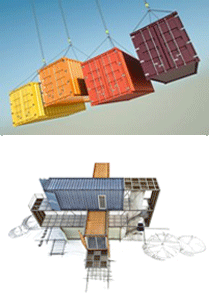- Home
- Building
- Transportation
- Dimensions
- Container Costs
- Used Containers
- 20 FOOT
- Book Store
- Container Sizes
- Companies
- Manufacturers
- Plans
- Drawings
- Used For Sale
- Projects
- Carriers
- Green House
- Benefits
- Construction
- Origins
- Design
- Specs
- Industry
- Refrigerated
- Cranes
- Open Tops
- Intermodal
- Insulated
- History
- Articles
- SCH Blog
- Contact us
- Submit your site
- Suggestions
- Privacy Policy
Types and configurations of ISO containers
ISO containers are one of the many different types of shipping containers that are available. Containers are basically of two types:
- standard containers, also referred to as ISO containers or intermodal containers;
- non standard shipping containers;
The ISO or intermodal rated containers conform to the International Organization for Standardization (ISO) container manufacturing standards. ISO is an international standards organization with the headquarters located in Geneva, Switzerland.
ISO containers are used to transport freight. They can be used to transport freight in more than one mode: truck and rail or rail and ship. That's why they are also referred to as intermodal containers.
There are many configurations of them:
- Dry ISO containers are used for general purpose transportation. The cargo is loaded from the end of the container. They are totally enclosed, box type containers. These containers are also called cube containers. They are manufactured with a standard height of 8 feet 6 inches, but also with extended heights of 9 feet 6 inches. The last ones are called high cube containers.
- Insulated or thermal ISO containers are used to transport chilled and frozen goods. They are also used for temperature sensitive products. These containers have insulated walls but they don't have a refrigeration unit.
- Refrigerated, or reefer ISO containers are used when a steady temperature must be maintained during shipping. They are the same as insulated containers but have a refrigeration unit.
- Flat racks and platforms are used to transport heavy machinery. They have no side walls, but may have end bulkheads. There are also collapsible flat rack containers. They are open sided containers with end bulkheads that can be folded down when the rack is empty.
- Open top containers are used to transport heavy, tall or hard to load cargo, and bulk material, such as coal or grain. They are box type containers with no top. They can be loaded from the top or end of the container.
- Tank type is used to transport liquid or bulk materials. They are manufactured with a cylindrical tank mounted within a rectangular steel framework. They have the same dimensions as other intermodal containers.
All these containers are manufactured in standard sizes:
- width: 8 feet;
- heights: 8 feet 6 inches and 9 feet 6 inches;
- lengths: 20 feet and 40 feet.
Less common lengths include 24, 28, 44, 45, 46, 48, 53, and 56 feet.
Swap bodies have many characteristics of the intermodal containers but are not ISO containers.
They are very popular in Europe. Their main characteristics are the strong bottom and a minimal upper body. They can have an open top. That allows them to be transferred from road to rail mode.
They also have bottom fittings so they can be locked onto either a road chassis or a rail car.
Swap bodies cannot be stacked and can only be bottom-lifted.
Useful Resources
Some information about the measurement system and conversions of ISO containers dimensions
